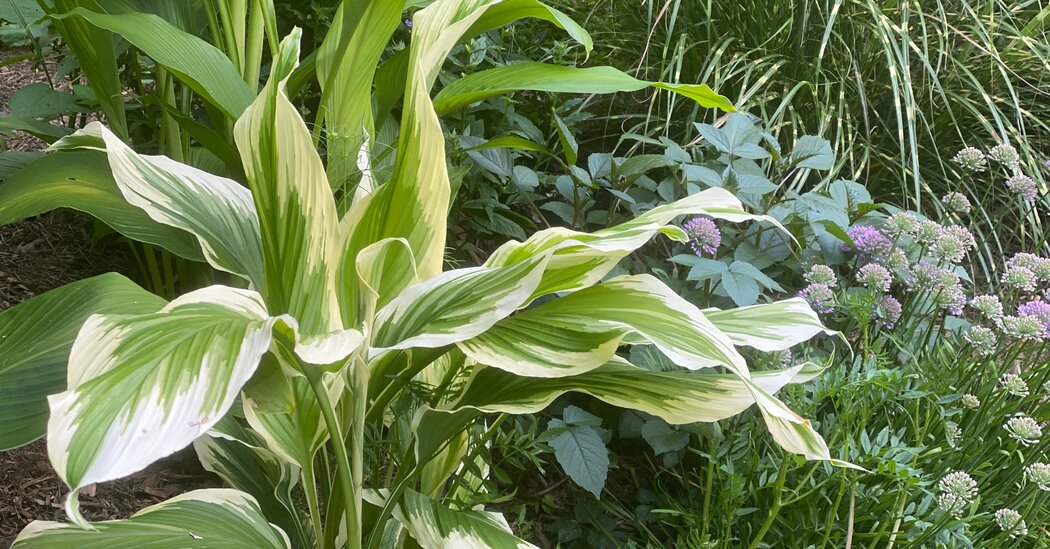Homegrown tastes of the tropics slumber in Marianne Willburn’s freezer — even now, when it’s almost as cold outside as it is in the suspended animation of that icy, dark compartment. And in the heat of peak growing season, the ginger, turmeric or lemongrass that she stashes to enliven a warming wintertime curry make themselves useful in the garden, adding a visual dash of a different climate zone.
It wasn’t always so for her, either inside or out.
“I really found them incongruous,” said Ms. Willburn, an author and gardener who lives in Virginia, recalling how she used to feel when she would see tropicals in the garden center in spring, barely awake and not looking like much of anything in their black nursery pots. “I thought, ‘Why would I put myself through the work of growing them here?’”
It was on a garden tour in North Carolina that her thinking began to evolve. She saw a range of tropical plants — red-leaved bananas and more — used artfully in a landscape of mostly hardy plants. They looked as if they belonged.
“When I saw them fused really well with temperate plants — taking all the good things of the temperate climate and adding this element — I was like, ‘Oh, now I’m paying attention,’” she said.
And then Ms. Willburn, a contributing editor to the collaborative blog Garden Rant and a passionate cook, learned something else: Some real beauties are also edible. The idea that she could grow the peppers, onions, tomatoes and cilantro for that curry or teriyaki sauce — and the seasonings, as well — had her hooked.
It was the start of some serious new long-term botanical relationships.
Ms. Willburn refers to plants that do ornamental service and also pay delicious dividends as “Friends with Benefits” in her 2021 book, “Tropical Plants and How to Love Them: Building a Relationship with Heat-Loving Plants When You Don’t Live in the Tropics.”
Other tender plants she has grown attached to are grouped under chapter titles with a similarly cheeky tone, including “The Long-Term Commitment” (those that star outdoors in season and later as houseplants), “The High-Maintenance Partner” (ones that require a lot of effort, but are worth it) and “The Summer Romance” (enjoy them for a summer and then compost).
She just cannot help herself — with the verbal playfulness, or when she spies a flashy new potential companion in the latest catalogs.
Ginger, Plain and Fancy
About this time of year, Ms. Willburn can’t help herself at the nearby world food market, either. She gives the stock of lemongrass (Cymbopogon citratus) a going-over for any stalks whose root ends look vaguely bulb-like, like those of scallions. Come spring, she could buy small nursery plants, but if some of those she sees now look promising, she’ll root them in water and then pot them up. They’ll be the starts of the grassy, gray-green background element she favors in her deck planters, where the foliage takes on tinges of purple come fall.
“It’s a great, cheap way to start playing with some of these tropical edibles,” she said.
Dried lemongrass leaves or stalks can be infused as a tea or added to a recipe (but as with bay leaf, remove them before serving). Ms. Willburn dries some, and each fall harvests maybe a dozen bulbs — the whiter area at the base — trimming them to about 12 inches and wrapping them in plastic to freeze. Then she’ll cut off two-inch segments as needed, to add to a dish she’s cooking.
Back in the produce section, she’s sifting through the bin of knobby brown culinary ginger rhizomes (Zingiber officinale), hunting for any with lively looking eyes, or growth points. She’ll pot them up for a head start in a warm, bright place, the way you would dahlias, and eventually transplant them to the sunny vegetable garden.
Because the common ginger’s narrow, almost bamboo-like foliage is not the main event, she relegates it to a background position in the garden, and her growing season isn’t long enough to produce flowers, or full-sized rhizomes.
But here’s the prize: the plant’s pinkish young rhizomes — tender baby ginger — that she slices thinly to pickle as gari, or sushi ginger.
Vastly more ornamental — and even perennial in Zone 6 or warmer — is myoga ginger (Zingiber mioga), an Asian woodland species and a popular culinary item in Japan. The variegated cultivars Dancing Crane and White Feather, which reach three or four feet tall, have established themselves among Ms. Willburn’s temperate shade-garden plants, like Rodgersia and Ligularia — strange (and wonderful) bedfellows.
And if their verticality and vivid foliage were not reason enough to make room for them, there’s more: Plant Delights Nursery is currently selecting among its myoga progeny for improved flower color, with plans to release more named varieties for gardeners hooked on ginger.
Myoga ginger’s culinary payoff is not a rhizome to dig. Instead, it comes in late summer or fall, down at ground level, when pinkish-purple shoots concealing unopened yellow flower buds push up, shaped “like very beautiful little lobster claws,” Ms. Willburn said. “I have to check those every single day for signs of bloom, or I won’t see it.”
Vigilance pays off, and the shoots are sliced to garnish a salad or to be pickled. Or — her favorite — made into tempura, “a delicious mouthful without that full-on ‘Wow, I just bit into a piece of ginger’ experience,” she said.
The Extended Family: Bananas, Cannas, Turmeric
Maybe the most familiar tropical for creating garden drama is canna, a distant cousin of ginger, from a common taxonomic order but a different family. Although the starchy rhizomes of certain canna species are eaten or made into flour in some countries, Ms. Willburn’s attraction is purely physical.
She has fallen hard for the orange-flowered Bengal Tiger, a real looker, with foliage striped gold and green. She sacrifices the occasional leaf for dinner-party décor: as a charger under plates.
Bananas, another distant cousin, are increasingly popular among gardeners who can offer sun, a hot summer and uniform soil moisture. The garden-worthy ones won’t produce edible fruit, but their leaves make good wrappers for steaming fish, chicken or maybe tamales. The hardiest, 6-plus-foot Musa basjoo, overwinters like a giant herbaceous perennial down to Zone 5.
The red Abyssinian banana (Ensete ventricosum Maurelii) is no such cold-hardy soul. Like the gingers, its fleshy roots are dug up. Then the plant is cut back to just above where the new leaves are forming, and it is wrapped in a dry towel and put into a closed drawstring plastic bag in Ms. Willburn’s frost-free garage, where it will remain all winter. It will still reach more than 10 feet tall the following season.
Like those of the banana and the Zingiber, rhizomes of various turmeric (Curcuma) plants, a closer ginger relative, are overwintered with her same “towel-wrapped-and-bagged treatment.”
Ms. Willburn’s cook self would not be without Curcuma longa, whose yellow rhizomes are the stuff of anti-inflammatory renown. The gardener in her goes for the cultivar Snowdrift, with its dramatic white variegation.
At harvest time, she sets aside some rhizomes to freeze. Later, she’ll take them straight from the freezer and use a hand-held microplane zester to grate some over the top of whatever she’s cooking.
“I’m not putting them into my morning juice or my power shake,” she said. “But a lot of people do.”
White turmeric (Curcuma zedoaria) has a bold maroon stripe down the center of each leaf. Like yellow turmeric, it reaches five feet tall in Ms. Willburn’s garden, but produces a much fatter rhizome, which she chops as a vegetable in the occasional curry or rice dish.
White turmerics pay extra dividends: As the leaves emerge in big clumps, so do flowers resembling oversized, bright-colored pine cones. And their canna-like leaves make great wrappers for steaming, imparting just a hint of spice.
Tasty, Fancy-Leaf Sweet Potatoes and a Climbing ‘Spinach’
No contemporary gardener needs convincing that fancy-leaved sweet potato vines (Ipomoea batatas) are decorative. Most of us, Ms. Willburn included, rely on their golden or purple foliage to fill out designs and cascade over the rims of containers.
But what caught her attention in 2020: The announcement that five varieties had been bred to combine that flashy foliage with the production of tasty, full-size tubers. The introductions, resulting from a breeding collaboration between the Louisiana State University Agricultural Center and FitzGerald Nurseries in Ireland, are marketed as Treasure Island sweet potatoes.
Sweet potato foliage is edible, too, and its leaves are often likened to those of spinach. So is maybe the easiest tropical touch of all, red-stemmed Malabar spinach (Basella rubra), which is grown from seed. This handsome, heat-loving provider of edible leaves can climb eight feet or so; it starts from an indoor sowing six to eight weeks before final frost and is transplanted alongside a trellis or other support after the weather warms.
Her list goes on (and on and on), but she offers a caveat: As with any relationships, if you try to juggle too many, you won’t be able to give each the attention it deserves — and it can get dizzying.
“I’m a convert to what these plants can do for your garden,” she said. “As long as you keep it manageable and don’t let them rule you. Grow what you love to use, and you’ll find that balance.”
Margaret Roach is the creator of the website and podcast A Way to Garden, and a book of the same name.
For weekly email updates on residential real estate news, sign up here.
Sumber: www.nytimes.com












